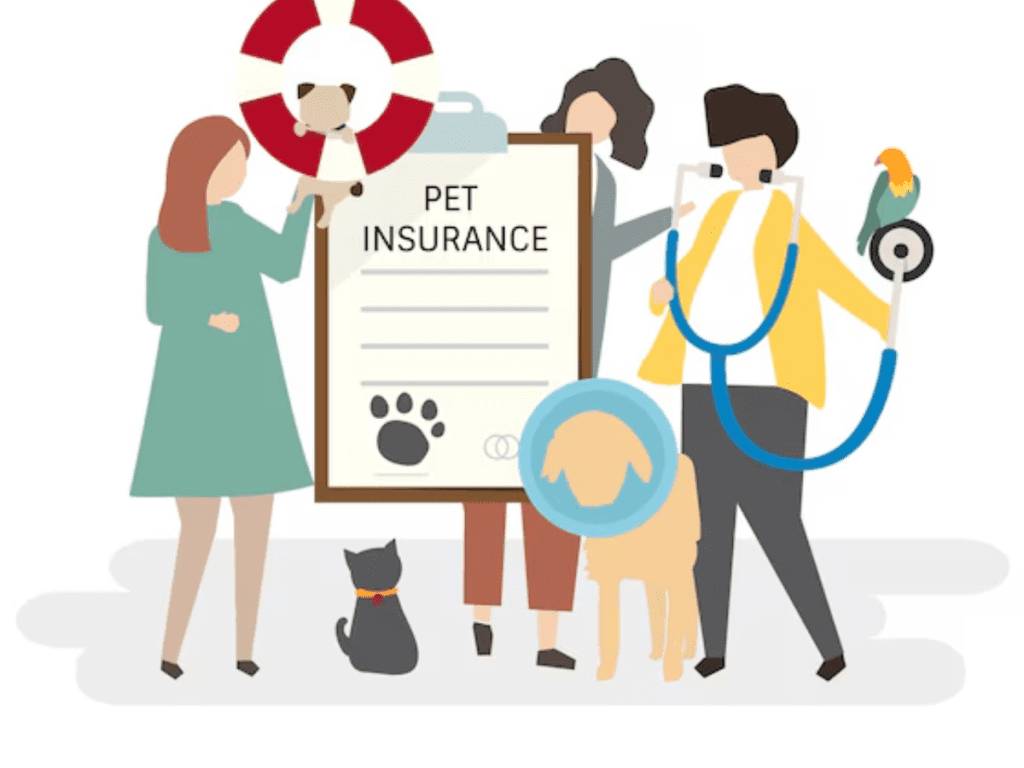Introduction
Pets bring joy, companionship, and unconditional love into our lives, becoming cherished members of our families. However, just as humans do, pets suffer from various illnesses, injuries, or chronic conditions that require medical attention. Veterinary care can be costly, especially in emergencies. The important financial tool for a responsible pet owner is pet insurance.
Pet insurance helps cover medical treatments, meaning that pets are provided with the best care while owners are relieved of the expense burden. We will discuss here how pet insurance works, what are its benefits, types of coverage, and factors that will affect the costs, the process of claims, and tips to choose the best policy.
What is Pet Insurance?
Pet insurance is one of the financial products aimed to help pet owners cover the expenses of veterinary services. Similar to human health insurance, it asks for a regular premium, paid monthly or yearly, in return for reimbursing part of the eligible medical expenses.
However, it does not exactly work like the health insurance plan of humans. Most policies would require the owners to pay up for the bill with the veterinary first and submit a claim afterward. The amount reimbursed varies on the percentage coverage of the policy, deduction, and percent reimbursement.
Why is Pet Insurance Important?
Many pet owners underestimate the cost of medical care for their pets. Routine vet visits, vaccinations, and preventive treatments can add up over time, while emergency procedures, surgeries, or long-term treatments for chronic conditions can be extremely costly.
Here are some reasons why pet insurance is beneficial:
- Financial Security – Unexpected medical expenses can be financially challenging. Pet insurance helps offset these costs.
- Increased Access to Medical Care : With pet insurance, the animal owner is sure to spend adequate money on advanced treatments like surgical procedures and a specialist visit.
- Confidence in Pet’s Life : Insurance coverage reduces worry about paying out-of-pocket, giving a more confident outlook at life.
- Catastrophic Protection : Accidents don’t always choose a specific day or time to occur, which means unexpected, expensive treatments become necessary. That’s when having insurance makes it easier.
How Does Pet Insurance Work?
Pet insurance works in several steps:
1. Choosing a Plan
Pet owners have to choose an insurance policy that meets the needs of their pet and their budget. Plans vary in terms of the level of coverage, deductibles, reimbursement percentages, and exclusions.
2. Paying Premiums
Insurance companies charge regular premiums to keep the policy active. The cost of premiums depends on factors such as the pet’s age, breed, location, and the chosen coverage plan.
3. Visiting the Veterinarian
If a pet becomes ill or injured, the owner takes them to a licensed veterinarian for medical attention. Unlike human health insurance, pet insurance usually does not require direct billing. That is, the owner pays the bill directly.
4. Paying the Vet Bill
The owner pays the vet bill in full after the animal has received medical attention.
5. Filing a Claim
The pet owner sends a claim to the insurance firm with additional documents like invoice statements, medical reports, and treatment evidence.
6. Receiving Reimbursement
The insurance company processes the claim and reimburses the owner depending on the terms of the policy. The rate of refund is normally determined by the percentage of reimbursement, the deductible and exclusion.
Types of Pet Insurance Coverage
Pet insurance policies vary according to the needs and budget of the owner. Here are some of the most common types:
1. Accident-Only Coverage
This type of policy covers injuries caused by accidents such as broken bones, ingestion of poison, or bite wounds. It usually costs the least but does not include illnesses or routine care.
2. Accident & Illness Coverage
This is the most popular form of pet insurance, covering both accidents and illnesses. This will include conditions such as infections, allergies, digestive issues, cancer, and hereditary diseases.
3. Comprehensive Coverage (Wellness Plan Add-On)
Some insurers offer additional wellness plans that cover routine care, such as vaccinations, dental cleanings, flea prevention, and annual check-ups. This is an optional add-on and not included in all standard plans.
Factors Affecting Pet Insurance Costs
The cost of pet insurance varies based on multiple factors, including:
- Pet’s Age – The older the pet, the more likely it is to develop health issues, so the insurance is costlier.
- Breed – Some breeds are prone to genetic conditions, which may increase the policy cost. For instance, large dog breeds are prone to hip dysplasia.
- Location – Veterinary costs vary from location to location, so the premium prices also vary.
- Coverage Type – More extensive policies with illness and wellness coverage are more expensive than accident-only policies.
- Deductible & Reimbursement Rate – A higher deductible reduces monthly premiums, and a higher reimbursement rate increases expenses.
Exclusions in Pet Insurance
Not all veterinary expenses are included in pet insurance. Some common exclusions include:
- Pre-existing conditions – Any illness or injury diagnosed before policy enrollment.
- Elective procedures – Cosmetic treatments such as tail docking or ear cropping.
- Breeding & Pregnancy-related issues – Some policies do not cover pregnancy complications.
- Preventive care – Routine checkups, vaccinations, and dental care (unless included in a wellness plan).
How to Choose the Right Pet Insurance
Choosing the right pet insurance plan takes a lot of thought. Here are some suggestions to guide you:
- Compare Different Providers- Compare several different companies to determine which offers the best coverage at the best price.
- Check Policy Exclusions- Understand what is not covered.
- Assess Your Pet’s Needs- Know your pet’s breed, age, and health history.
- Look for Customer Reviews – Read feedback from other pet owners about their experiences with different insurance companies.
- Consider Reimbursement Options – Choose a reimbursement rate that balances affordability and coverage.
How to File a Pet Insurance Claim
Filing a pet insurance claim is straightforward. Here’s a step-by-step process:
- Get Treatment – Take your pet to a licensed veterinarian for medical care.
- Collect Required Documents – Gather invoices, medical records, and any other necessary paperwork.
- Submit the Claim – Fill out the insurance provider’s claim form and submit it along with supporting documents.
- Wait for Processing – The insurance company reviews the claim and determines the reimbursement amount.
- Receive Reimbursement – If approved, the insurer transfers the funds to your account based on the agreed reimbursement percentage.
Alternatives to Pet Insurance
If pet insurance is not an option, pet owners can consider alternatives such as:
- Pet Savings Account – Setting aside money each month for unexpected medical expenses.
- Veterinary Discount Programs – Some vets offer memberships or discount plans for routine care.
- Charity & Assistance Programs – Non-profit organizations may provide financial aid for pet medical expenses.
Common Myths and Misconceptions About Pet Insurance
Many pet owners hesitate to purchase pet insurance due to misconceptions. Let’s debunk some common myths:
1. “Pet Insurance Isn’t Worth It”
Some believe that pet insurance is an unnecessary expense. However, a single emergency vet visit can cost thousands of dollars, making insurance a financial safety net for unexpected situations.
2. “Pet Insurance Covers Everything”
While pet insurance provides financial relief, it does not cover every medical expense. Most policies exclude pre-existing conditions, elective procedures, and some routine care unless an additional wellness plan is purchased.
3. “I Can Get Pet Insurance When My Pet Gets Sick”
Pet insurance does not cover pre-existing conditions. Ideally, it is crucial to enroll a pet when they are young and healthy to maximize the benefits of coverage.
4. “All Pet Insurance Plans Are the Same”
There is a great deal of difference in coverage, reimbursement rates, waiting periods, and exclusions between policies. It is necessary to compare plans to find the best fit.
5. “Pet Insurance Works Like Human Health Insurance”
Unlike human insurance, most pet insurance requires the owner to initially pay the full vet bill and later claim reimbursement. In most cases, there is no direct billing system.
How to Maximize Your Pet Insurance Benefits
To get the most out of a pet insurance policy, consider the following strategies:
1. Enroll Early
The younger the pet, the lesser the preexisting conditions they may have, hence carrying lower premiums and fuller coverage.
2. Understand Your Policy
Read all the fine print, especially around exclusions, waiting periods, and reimbursement percentage.
3. Keep Medical Records Organized
Keeping detailed veterinary records can speed up the claims process and also prevent disputes with the insurance provider.
4. Select the Appropriate Deductible
A higher deductible means lower monthly premiums, but a lower deductible means higher reimbursements. There is a balance that will suit your budget.
5. Take Advantage of Preventive
Care Some policies include wellness plans that cover routine checkups, vaccinations, and flea/tick prevention. This can help prevent costly medical issues.
Pet Insurance Providers: What to Look For
When choosing a pet insurance provider, consider:
- Reputation – Look for customer reviews and ratings.
- Claim Process – Choose a provider with an easy and fast claims process.
- Customization – Some insurers allow customization of coverage, deductibles, and reimbursement rates.
- Customer Support – Reliable customer service is essential for addressing concerns and inquiries.
Real-Life Scenarios: When Pet Insurance Saves the Day
1. Emergency Surgery
A dog swallows a foreign object, requiring emergency surgery costing $5,000. With pet insurance covering 80%, the owner only pays $1,000.
2. Chronic Illness
A cat becomes diabetic and needs ongoing treatment. The medical bills come to $3,000 a year without insurance. With coverage, the owner saves thousands.
3. Accidental Injury
A pet is hit by a car and requires multiple surgeries. The total cost was $8,000, but pet insurance paid for most of it, thus reducing the cost.

